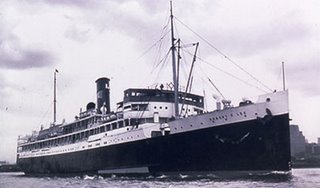1521: Magellan killed in the Philippines

After traveling three-quarters of the way around the globe, Portuguese navigator Ferdinand Magellan is killed during a tribal skirmish on Mactan Island. Magellan was helping a local chief conquer a rival tribe when he was injured and left behind by his retreating comrades. In 1520, his expedition had set out from Spain to find a western passage to Indonesia. After sailing through the dangerous straits below South America that now bear his name, he became the first European to reach the Pacific Ocean from the Atlantic. Encountering waters so strangely calm that Magellan named the ocean Pacific, his fleet spent 99 days making their westward crossing. After his death in the Philippines, his ships continued the journey and one of the five original ships returned to Spain in September 1522, thus completing the first circumnavigation of the world.
1993In a referendum, Eritreans vote overwhelmingly for independence from Ethiopia.
1981Former Beatle Ringo Starr marries American actress Barbara Bach.
1974A Soviet airliner crashes shortly after take-off from Leningrad Airport killing all 108 passengers and crew on board.
1972US Apollo 16 spacecraft safely crash lands in the Pacific Ocean after taking three astronauts to the Moon.
1968The Abortion Act legalises abortion in Britain.
1967Opening of the Expo 67 Exhibition in Montreal.
1961Sierra Leone gains independence.
1950Britain officially recognises the State of Israel.
1950The Communist Party is outlawed in Australia.
1943Britain's first professional women's jockey makes her racing debut.
1941World War II: Athens falls to the German invaders after 180 days of Greek resistance.
1938Greece and Turkey sign a treaty of friendship.
1937The world's longest suspension bridge, the Golden Gate Bridge in San Francisco, is officially opened. Its length: 4,200 feet.
1910Louis Botha and James Hertzob officially found the South African Party.
1908Start of the Fourth Modern Olympic Games in London (April 27-October 31). Britain heads the medal table winning 56 gold.
1830Simon Bolivar abdicates from his position of President of Colombia.
1828Opening of the London Zoological Gardens in Regent's Park, London.
1810Beethoven publishes his latest composition for the piano, Fur Elise.
1964British singer Sheena Easton.
1939British actress Judy Carne.
1927English air pioneer Sheila Scott.
1904Irish poet and writer Cecil Day-Lewis - pseudonym of Nicholas Blake.
1822USA President and Army General Ulysses S.Grant.
1791USA inventor Samuel Morse is born in Massachusetts. Inventor of the Morse Code - a system of sending messages via an electric wire.
1737English historian Edward Gibbon. Author of The Decline & Fall of the Roman Empire.
1521Portuguese navigator and explorer Ferdinand Magellan is killed by natives in the Philippine Islands.


































